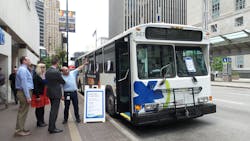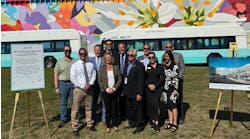Metro displayed its oldest bus in operation on May 19 in an effort to highlight the nation’s urgent need to consistently invest and maintain its aging infrastructure, including one of America’s most valuable assets – its public transportation systems.
While Metro maintains its 357-vehicle fleet for the highest level of safety, the oldest bus, now 15-years-old, is several years past its 12-year life expectancy and has been driven almost 500,000 miles. Purchased in 2001 for $242,111, the cost to replace a bus in 2016 is now approximately $440,000. Metro currently has 85 buses in its fleet past the 12-year age and in urgent need of replacement.
Nationwide, according to the latest data from 2013, the Federal Transit Administration says that more than 40 percent of buses and 25 percent of rail transit assets were in marginal or poor condition. FTA also noted that there is an $86 billion backlog in deferred maintenance and replacement needs.
That’s why Metro has joined more than 100 transit agencies, businesses, labor and policy-making leaders in recognition of National Infrastructure Week to show how transportation, including highways, roads, bridges, public transportation, and bike trails serve as the backbone of our nation’s economy, connecting millions of people with jobs, schools, shopping and medical services.
The public was invited to board the bus and learn about the true costs of operating an aging system, as well as what they could do to show their support for public transportation.
“In order for us to meet 21st century transportation requirements we need dollars for infrastructure,” said Cincinnati Metro CEO & GM Dwight A. Ferrell. “The more money invested in public transportation allows us to provide a more reliable service, which helps us grow our economy and be a part of the catalyst that attracts jobs to our region.”




